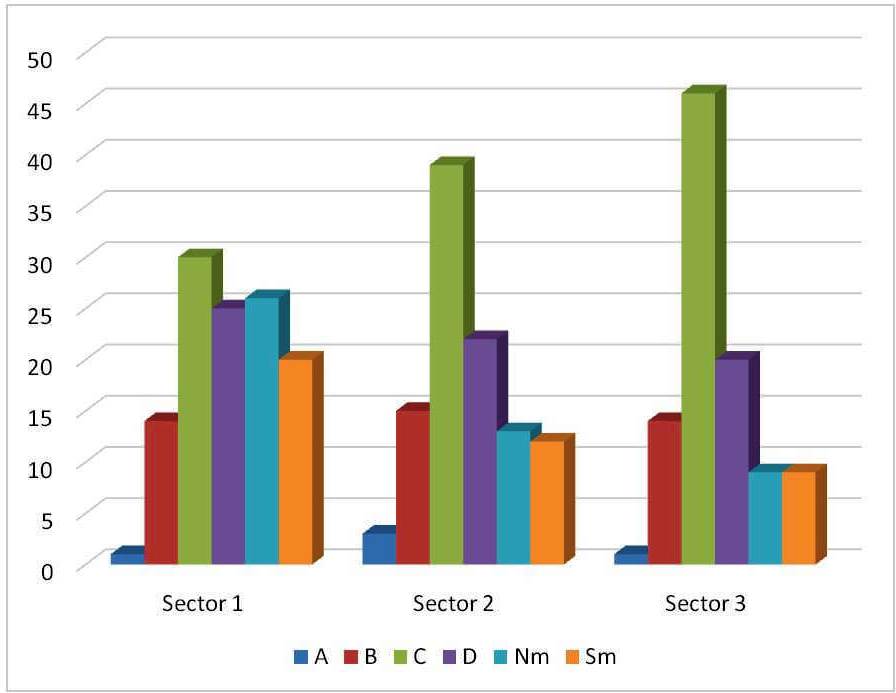The Alps are the highest and largest mountain range in Europe, and extend across most Central European countries. As a result of their unique characteristics, this mountain range has a notorious diversity of plants species living there (approximately 4.500). However, they are not evenly distributed.
There are many factors that can constrain the plants growth, such as altitude, humidity, wind speed, soil and precipitation. This is an explanation for why there are plants that can only appear in some specific conditions.
The chosen areas for this article were located near the Ova da Buffalora river, in Val Mustair, Canton of Grisons, Switzerland. There, the soil was a heterogenic mixture of rocks (dolomite and verrucano), which made it permeable, allowing the water to go through, and rich soil covered in flowers and grass.

Species count in each area
There were selected three even areas, as to make the survey easier. Later, the three areas were divided into four different categories: A (The zone which always had water in it); B (Anywhere until 2m towards the water); C (Intermediary); and D (The surrounding meadows).
After, the species found in all the different areas were catalogued and it was easy to conclude that this place is nothing like the rest. 56 species of plants were recorded. The scientists were amazed at the quantity and variety of plants they could find in such a small area.
Many species were found in the riverbed. However, only a few could actually live in the water. This occurs because some plants are just not as resistant to environmental factors as others, most likely due to natural selection processes during their evolutionary period. For example, Tussilago farfara, also known as coltsfoot, is a perennial herbaceous found in colonies of dozens which can be found almost anywhere in the world. This makes this plant highly adaptable, and therefore a strong specie, something that could be easily verified, because it could be found in al the sectors. Yet, plants like Leontopodium alpinum, also, and more commonly known as Edelweiss, exist only in one of the sectors (sector D).
The results indicate that the great majority of the plants in the areas nearer the water came from the meadows above, since they also exist there. However, it is also possible that some plants might have been transported by the river, since they were not found in the surrounding meadows and could be found in all of the sectors. This hypothesis is supported by the knowledge that it is possible for seeds and spores to be carried by the river from the mountain to the riverbed in study.
Sector A is the most hostile to plants, because of the water. The river is, in this case a problem, since the plants need time to to grow and fixate their roots, and they might not have time to do so in the presence of a constant stream of water, pulling them away from the soil. Adding to this the terrain in this area is not the most fertile one, considering that it consists largely of rocks.
Sector B, on the other hand, has a lot of life in it, since there is easy access to water and more protection from the wind than in the meadow. There is only one problem which seamed to be holding back the plants from growing there, the soil. Here, like in sector A, the soil is the main difficulty for life, as it is very rocky, and even though there are nutrients (which are good for plants enabling them to grow stronger) it’s also very permeable, so the water can get through. The rocks themselves are also a problem since they can move around easily and destroy the plants they find in their way.
Most to our surprise, plants seemed find it hard to thrive in sector C’s soil. The plants that live in this environment must come mostly from seeds or spores transported by the wind or by animals, since the river action is not as severe as in Sectors A and B.
Last of all there is sector D. In there we could find a large variety of plants. This occurs because this was, out of the four the one who offered the best conditions to the displaying of life. Even though the soil still has a lot of rocks, at least by most people’s standards, it retains water better. Its stability allows trees to grow, and their roots can sustain the water, or at least moisture in the upper layers of the ground, allowing other plants to use this water as well.
The plants that live only in the riverbed could have possibly come from the mountains. This means that their seeds were transported by the river, the wind or animals. An example is Linaria alpina, which is occasionally found at lower altitudes when seeds are brought down from the mountains with runoff water (Landolt /Urbanska 2003). Another example is Epilobium fleischeri, which is typical for alluvial areas, talus, stony and base-rich soils (Landolt /Urbanska 2003). A final example is Saxifraga aizoides, which lives in scree, flushes, stony and intermittently humid soil (Landolt /Urbanska 2003). The the hypothesis is that not all plants can live in the riverbed. Only the more resistant can grow there, due to their capacity to adapt to all different types of conditions.
Thanks:
We would like to thank Schweizer Jugend Forscht as well as Fundação da Juventude, Instituto de Medicina Molecular (Doutora Teresa Carvalho, Doutora Sandra Martins), Colégio Valsassina (Dr. João Gomes, Dr. João Valsassina) Escuela Suiza de Barcelona for giving us the possibility to take part in such an interesting project as the IWRW, granting us the opportunity to write about such interesting natural facts.
Literature/References:
Lauber K., Wagner G. (1996). Flora Helvetica. Haupt, Bern.
Landolt E., Urbanska KM. (2003). Our Alpine Flora. (2nd Edition). SAC Publications, Zurich.



You must be logged in to post a comment.